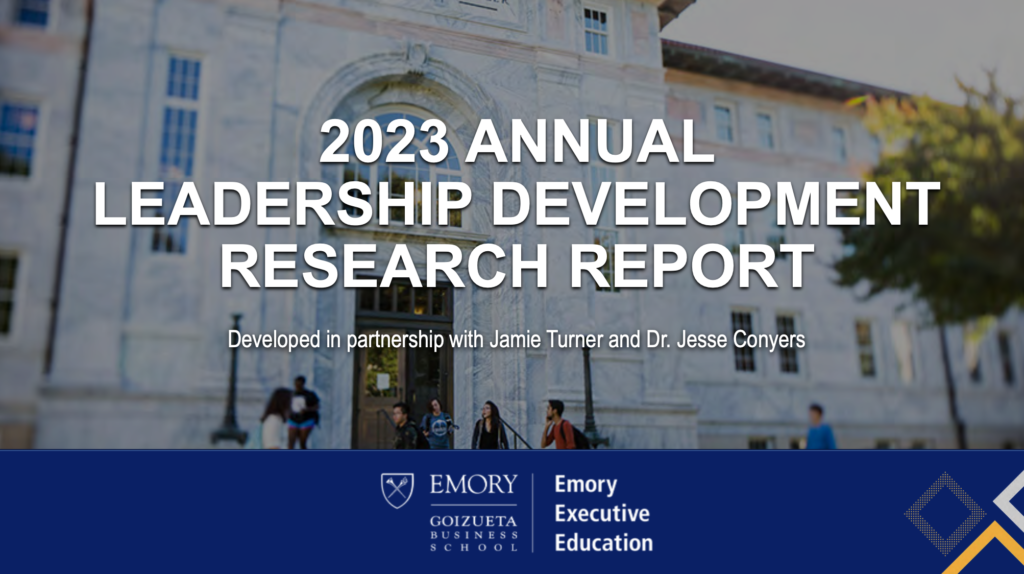Is leadership development training a good investment? That’s a question many people in human resources, talent development, and employee training get asked all the time.
Good news. We have the answer to that question and a whole lot more in the 2023 version of our Second Annual Leadership Development Research Report which can be downloaded at the bottom of this post.
Here are some of the key findings you’ll learn in the report.
- The need for training and development remains important: 83% of survey respondents said the need for training and development is greater today than it was 5 years ago (this increased from 80% in 2022)
- Training and development budgets are less likely to increase this year: Only 25% of those surveyed said they were likely or very likely to see an increase in their budgets in the coming year. This is down from 54% in 2022.
- It is easier to attract new employees in 2023 vs. 2022: In 2022, 79% of survey respondents said it was harder to attract new employees than it was 5 years ago. In 2023, that figure dropped to 69%, indicating that it’s slightly easier to hire in 2023 than it was in 2022.
- Executive teams are less involved in talent development: 56% of survey respondents said their organization’s executive team is very involved in talent development, which has decreased from 74% in 2022.
- In 2023, organizations were less focused on developing the next generation of leaders than in 2022: 45% of those surveyed said their organization has a clear focus on developing the next generation of leaders, down from 63% in 2022.
And here are some of the key action steps from the report.
The need for continuous leadership development is real. Leadership is no longer confined to traditional hierarchical structures; it’s about fostering innovation, driving collaboration, and inspiring teams towards shared goals.
Action Step: Prioritize investing in ongoing training and development initiatives to enhance employee skills and capabilities. Refine existing leadership development programs to meet evolving needs.
Economic uncertainty has affected budgets for training and development programs. While some organizations are exercising caution in regards to budgets, the recognition of leadership development’s long-term value and its potential impact on organizational success underscores the need to find innovative ways to empower leaders without compromising finances. Creative solutions, such as leveraging cost-effective online training platforms, tailoring in-house workshops, or exploring partnerships, can help optimize training initiatives within budgetary confines.
Action Step: Focus on optimizing existing training resources and seeking cost-effective solutions to ensure effective skill development despite budget limitations.
Employee recruitment and retention is changing. With the rise of remote work and increased focus on work-life balance, businesses are adapting their recruitment strategies. Simultaneously, retention strategies are taking center stage, emphasizing personalized career paths, skill development, and work environment. Top businesses are recognizing employee loyalty is built on meaningful engagement, continuous development, and commitment to employee well-being.
Action Step: Capitalize on the improved ease of attracting new employees by showcasing unique value propositions and growth opportunities within the organization. Implement retention strategies such as tailored career paths and recognition programs to ensure a sustainable talent pool.
Cultivating the next generation of leaders is critical. Focusing on developing the next generation of leaders is an investment in an organization’s long-term success, stability, innovation, and reputation.
Action Step: Revise strategies to prioritize development of the next generation of leaders within the organization. Strategically allocate resources, time, and staff to develop the next generation of leaders. Tailor leadership development programs to attract that align with career aspirations.
In the end, what differentiates your business are the people. Despite rapidly developing technology, people skills remain the top areas of focus for high performing organizations.
Action Step: Design training programs that foster interpersonal skills, team management, and collaboration to enhance leadership effectiveness.
Succession planning is critical. By cultivating a pool of capable successors, organizations minimize disruptions and maintain a smooth transition, safeguarding institutional knowledge and sustaining momentum. Succession planning not only demonstrates commitment to employee growth and advancement but also fosters a culture of accountability and preparedness, positioning the organization for long-term success.
Action Step: Establish comprehensive succession plans to ensure a smooth transition as key positions become vacant due to retirements or promotions. Implement knowledge transfer strategies to capture critical institutional knowledge as experienced leaders transition out of the organization.
Interested in downloading the full report? Just click the image below my bio and download it instantly.
About the Author: Jamie Turner is an internationally recognized author, professor, consultant, and speaker who has helped employees at The Coca-Cola Company, Holiday Inn, Verizon, Mercedes-Benz and others do a better job leading, managing, and mentoring others. To have him speak at your event or organization, email him at: Jamie@JamieTurner.Live
